|
|
|
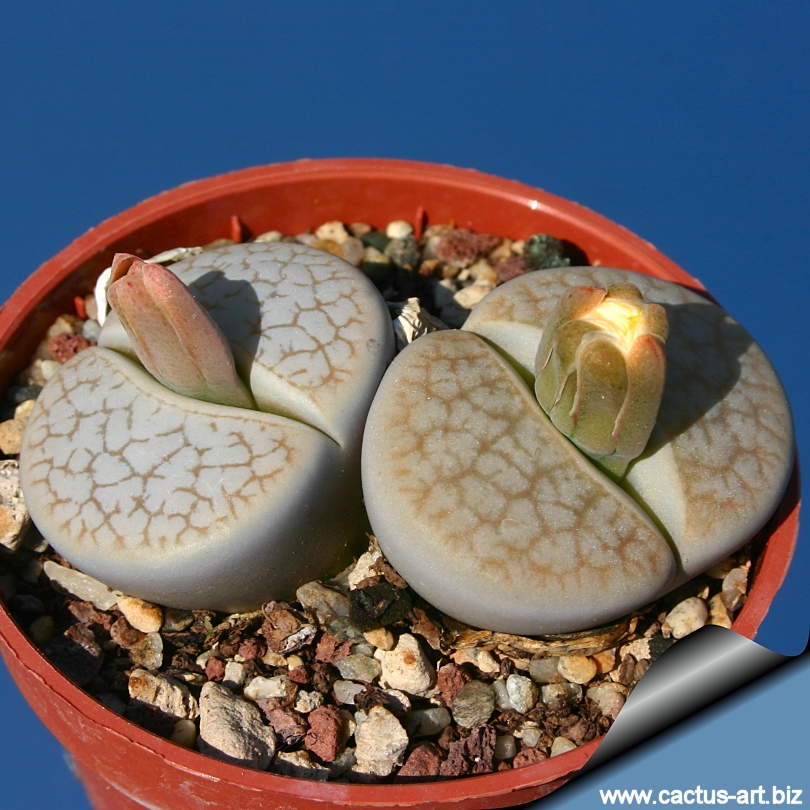
Lithops pseudotruncatella subsp. dendritica var. farinosa C245
It has pale blue-grey to grey body with brown branched
markings and is one the more robust
and easy growing plants in the genus.
|
|
Description: Lithops
pseudotruncatella is a very free-
growing species, forming clumps. It was one of first plant of this genus
discovered and for a long time one of the first representative in
European collections. Generally this Lithops is
characterized by greyish
colour with darker ramosely branched
marbling on the upper surfaces,
but it is also a very variable taxon in which a number of variety and
forms has been described. The status of these is uncertain.
The body is medium to very large, solitary or
variously branched with more of 20 heads. Facial diameters 25-50 X
20-35 mm and up to 4 cm tall.
Flowers: Yellow (occasionally white), medium to very large, up to
50 mm Ø, mostly 25-40 mm Ø.
Lithops
pseudotruncatella comprises several more or less intergrading and
distinct variety:
- ssp. pseudotruncatella
(N.E. Brown) N.E. Brown 1908. Cole numbers:
C067, C070, C263, C315 “alpina”, C068, C381 “mundtii”, C099,
C100 “clear form”.
It is a medium to very large sized elliptical plant about 40 X 30 mm
wide, the body is flat to slightly convex with a shallow fissure,and
lobes conjunct. It branches easily and forms clumps with up to 20 (or
more) heads, but usually less. It is somewhat variable in colour,
usually opaque, smooth to very slightly rugose, uniform pale grey or
beige tinted with variously shaded. Face, margins and shoulders dull
grey. Windows and margins usually not clearly distinguishable, In the
upper surface there a broken network of irregularly and extensively
branched tree-like rubrications that sometimes are reduced to a
scattering of short lines, dashes and dots; the ends often finely
ramose and tapering off into the outer margins.
- ssp. pseudotruncatella var. elisabethiae
(Dinter) De Boer & Boom 1933 Cole numbers:
C187
It is quite similar to the standard
variety but whit a peculiar bluish-pink colour.
- ssp. pseudotruncatella var. riehmerae
D.T. Cole 1987 “edithiae” (var. edithae (N.E.Brown) De Boer) Cole
numbers: C097
Not very different from the standard variety, it differs mainly in its
generally smaller size. The head colour is pale grey colour with less
extensive markings.
- ssp. archerae
(De Boer) Cole 1967 (L. archeri De Boer) Cole
numbers: C104, C306
This subspecies is easily recognized for
its truncate profile and round-elliptic face, the uniform milky
grey-green colour is also very characteristic of this plant.
- ssp. dendritica (Nel) De Boer &
Boom 1946(L. dendritica Nel. L. farinosa
Dinter.) Cole numbers: C072, C073, C357,
C384, “farinosa”
C245, “pulmonuncula”C071(var.
pulmuncola (Jacobsen) Jacobsen)
This form is distinguishable for the more regularly branched
channels and rubrications that forms an almost a honeycomb pattern.
The face has usually a reddish colour.
- ssp. groendrayensis (Jacobs.) D.T.
Cole 1961. Cole numbers: C239, C244 “Witkop form”, C246 Pale
grey-white in colour with minutely pin-pricked or wrinkled top
surface.
- ssp. volkii (Schwant. ex H.W. de
Boer & B.K. Boom) D.T. Cole 1961 Cole numbers: C069
The face of this form is pale bluish-white with very few
rubrications and few or no dusky dots.a
Cultivars:
- ssp. pseudotruncatella
cv. Albiflora “White flowering-form”. Cole
numbers: C264
This cultivar has white flowers instead
of yellow, but the plant is identifiable only when in flower.
- ssp. Archerae cv. 'Split Pea'
1999 Green form.
|
|
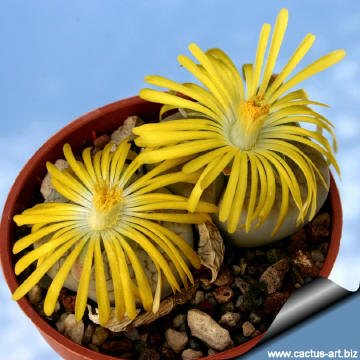 |
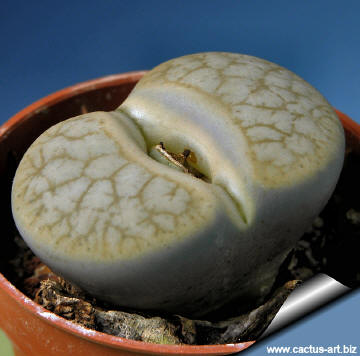 |
|
. |
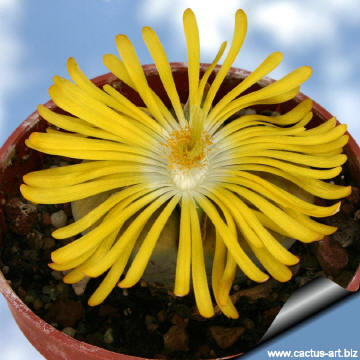 |
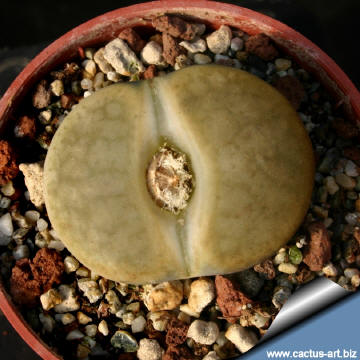 |
|
. |
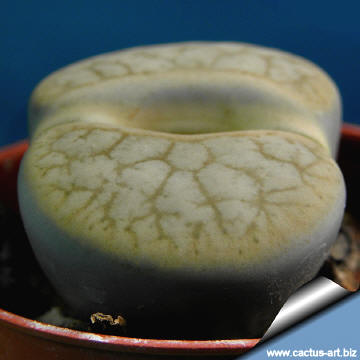 |
 |
|
Advertising
|
|
|
|
|
Family: Mesebrianthemaceae (Aizoaceae)
Scientific name: Lithops
pseudotruncatella (Berg.) N.E. Br. (1908) subsp. dendritic
var. farinosa
Origin: Namibia, It is found in an wide around
Windhoek with a radius of about 40 km, but with a large extension
projecting some 120 km beyond Steinhausen to the NE.
Habitat: Habitat: It is found growing among quartzite and
mica schist stones.
Common English Names include: Stone plant, living stone.
Etymology: The species name comes from the Latin words 'pseudo'
meaning 'false or resembling', and 'truncatella 'somewhat truncate'.
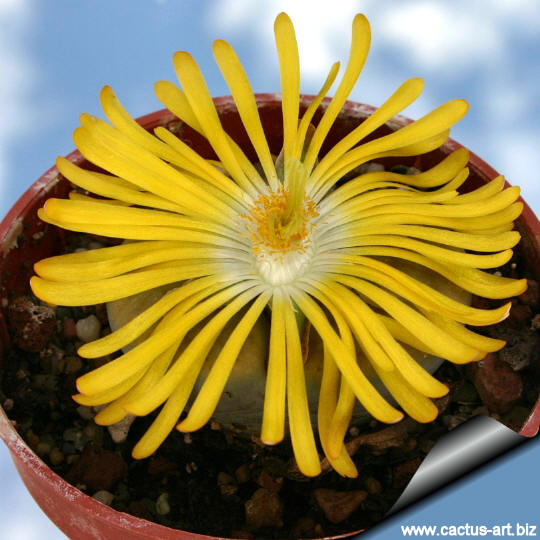
|
|
|
|
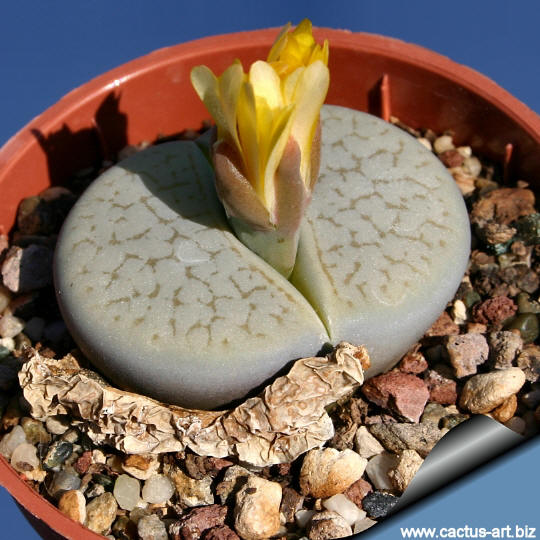
Lithops pseudotruncatella flowers early at the beginning of september
(15 to 30 days before all the other lithops). The flowers are golden
yellow
Remarks: Lithops are
partly subterranean, with only the clear 'window'
in each leaf tip exposed above soil. A type of optical system exists
whereby a layer of apical tissue rich in calcium oxalate crystals acts
as a filter to intense sunlight before it reaches the thin
chlorophyllous layer below. They are also called
mimicry plants as they show a striking similarity to their
background rocks and are difficult to detect when not in flower. These
are the commonly known as pebble plants or living stones; each species
is associated with one particular type of rock formation and occurs
nowhere else. Its soil-embedded, subterranean growth form also reduces
the need for chemical defences against herbivores.
Cultivation:
Need an open mineral, fast draining mix and the maximum amount of light
you are able to give them. The basic cultivation routine is: Stop
watering after flowering. Start watering after the old leaves completely
dry. (Usually late March or Early April) Water freely during the growing
season, soak the compost fully but allow it to dry out between waterings,
no water when cold. Some growers fertilize
frequently, some hardly ever. Keep them dry during the winter. Nearly
all problems occur as a result of
overwatering and poor ventilation especially when weather
conditions are dull and cool or very humid. This plant is best
for a well lit area (Bright
shade to
full sun). But don't be afraid even
the best growers have plants that mysteriously dry up, or leave during
the night.
Note: After flowering in the
autumn and extending through
winter
season the plant doesn’t need
watering, but they will still be
growing, the new
bodies will be increasing in size extracting
water from the outer
succulent leaves, allowing them to
shrivel away. In fact the plant in this time extracts
water and
nutrient stored in the outer
succulent leaves, allowing them to
dehydrate relocating the water to the rest of the plant and to the
new leaves that form during this period until the old leaves are reduced
to nothing more than "thin papery shells".
Photo of conspecific taxa, varieties, forms and cultivars of
Lithops pseudotruncatella.

 |
|